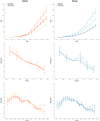Changing Patterns in Cancer Mortality from 1987 to 2020 in China
- PMID: 36672425
- PMCID: PMC9856369
- DOI: 10.3390/cancers15020476
Changing Patterns in Cancer Mortality from 1987 to 2020 in China
Abstract
Background: China has the highest number of new cancer cases and deaths worldwide, posing huge health and economic burdens to society and affected families. This study comprehensively analyzed secular trends of national cancer mortality statistics to inform future prevention and intervention programs in China.
Methods: The annual estimate of overall cancer mortality and its major subtypes were derived from the National Health Commission (NHC). Joinpoint analysis was used to detect changes in trends, and we used age-period-cohort modeling to estimate cohort and period effects in Cancers between 1987 and 2020. Net drift (overall annual percentage change), local drift (annual percentage change in each age group), longitudinal age curves (expected longitudinal age-specific rate), and period (cohort) relative risks were calculated.
Results: The age-standardized cancer mortality in urban China has shown a steady downward trend but has not decreased significantly in rural areas. Almost all cancer deaths in urban areas have shown a downward trend, except for colorectal cancer in men. Decreasing mortality from cancers in rural of the stomach, esophagus, liver, leukemia, and nasopharynx was observed, while lung, colorectal cancer female breast, and cervical cancer mortality increased. Birth cohort risks peaked in the cohorts born around 1920-1930 and tended to decline in successive cohorts for most cancers except for leukemia, lung cancer in rural, and breast and cervical cancer in females, whose relative risks were rising in the very recent cohorts. In addition, mortality rates for almost all types of cancer in older Chinese show an upward trend.
Conclusions: Although the age-standardized overall cancer mortality rate has declined, and the urban-rural gap narrowed, the absolute cancer cases kept increasing due to the growing elderly population in China. The rising mortality related to lung, colorectal, female breast, and cervical cancer should receive higher priority in managing cancer burden and calls for targeted public health actions to reverse the trend.
Keywords: China; age-period-cohort effects; cancer mortality; long-term trends; urban-rural disparity.
Conflict of interest statement
The authors have declared no conflicts of interest.
Figures



Similar articles
-
Trends in cancer mortality in China: an update.Ann Oncol. 2012 Oct;23(10):2755-2762. doi: 10.1093/annonc/mds069. Epub 2012 Apr 6. Ann Oncol. 2012. PMID: 22492700
-
The long-term changing patterns of suicide mortality in China from 1987 to 2020: continuing urban-rural disparity.BMC Public Health. 2024 May 9;24(1):1269. doi: 10.1186/s12889-024-18743-z. BMC Public Health. 2024. PMID: 38725017 Free PMC article.
-
Comparison of Secular Trends in Cervical Cancer Mortality in China and the United States: An Age-Period-Cohort Analysis.Int J Environ Res Public Health. 2016 Nov 17;13(11):1148. doi: 10.3390/ijerph13111148. Int J Environ Res Public Health. 2016. PMID: 27869688 Free PMC article.
-
Trends in Diabetes Mortality in Urban and Rural China, 1987-2019: A Joinpoint Regression Analysis.Front Endocrinol (Lausanne). 2022 Jan 17;12:777654. doi: 10.3389/fendo.2021.777654. eCollection 2021. Front Endocrinol (Lausanne). 2022. PMID: 35111135 Free PMC article.
-
[Mortality Atlas of the Campania Region. All-cause and cause-specific mortality at municipal level, 2006-2014].Epidemiol Prev. 2020 Jan-Feb;44(1 Suppl 1):1-144. doi: 10.19191/EP20.1.S1.P001.003. Epidemiol Prev. 2020. PMID: 33565290 Review. Italian.
Cited by
-
Analysis of trends in cancer mortality and the years of life lost in six provinces in northwest China from 2013 to 2021.Sci Rep. 2025 Feb 24;15(1):6558. doi: 10.1038/s41598-025-88941-1. Sci Rep. 2025. PMID: 39994252 Free PMC article.
-
Gender disparities in multi-state health transitions and life expectancy among the ≥50-year-old population: A cross-national multi-cohort study.J Glob Health. 2024 Sep 6;14:04156. doi: 10.7189/jogh.14.04156. J Glob Health. 2024. PMID: 39238364 Free PMC article.
-
Roles of LncRNA ARSR in tumor proliferation, drug resistance, and lipid and cholesterol metabolism.Clin Transl Oncol. 2025 Apr;27(4):1356-1365. doi: 10.1007/s12094-024-03700-4. Epub 2024 Sep 9. Clin Transl Oncol. 2025. PMID: 39251493 Review.
-
Temporal trend in non-melanoma skin cancer mortality in China, 1992-2021: an analysis for the global burden of disease study 2021.Front Med (Lausanne). 2025 May 14;12:1495454. doi: 10.3389/fmed.2025.1495454. eCollection 2025. Front Med (Lausanne). 2025. PMID: 40438371 Free PMC article.
-
Age-Period-Cohort Analysis on Long-Term Mortality Trend of Genitourinary Diseases - China, 1987-2021.China CDC Wkly. 2023 Dec 22;5(51):1135-1139. doi: 10.46234/ccdcw2023.212. China CDC Wkly. 2023. PMID: 38152632 Free PMC article.
References
-
- Zhou M., Wang H., Zeng X., Yin P., Zhu J., Chen W., Li X., Wang L., Wang L., Liu Y., et al. Mortality, morbidity, and risk factors in China and its provinces, 1990–2017: A systematic analysis for the Global Burden of Disease Study 2017. Lancet. 2019;394:1145–1158. doi: 10.1016/S0140-6736(19)30427-1. - DOI - PMC - PubMed
Grants and funding
LinkOut - more resources
Full Text Sources
Miscellaneous

